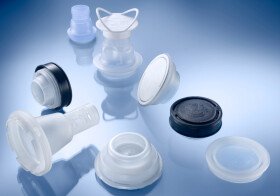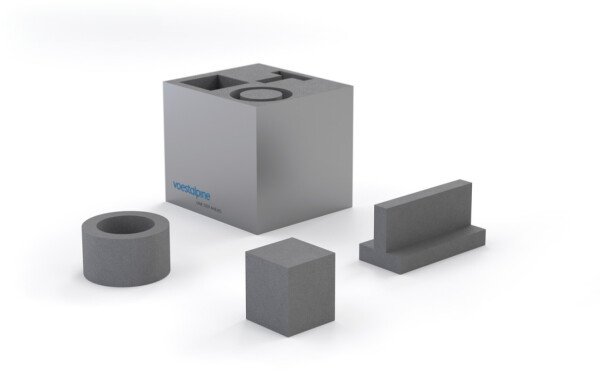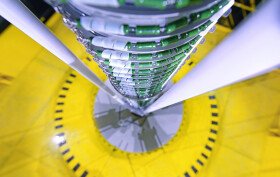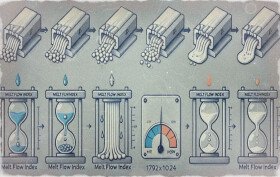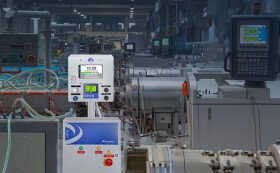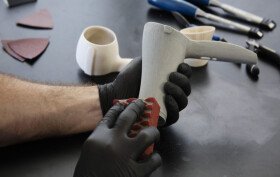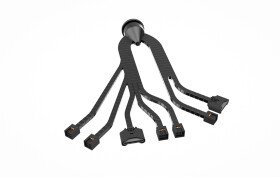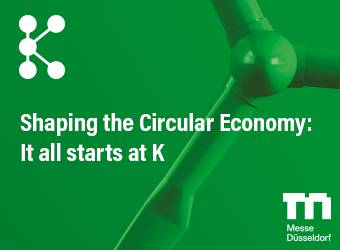Radiation Crosslinking – way to improve the properties of polymers, Part 3
3.2.2. Creep behavior
Creep is an important property for polymers that are being used under constant stress for a long time such as pipes, wires, storage tanks, etc. By common knowledge, crosslinking can enhance the creep resistance of polymers. Effects of crosslinking on creep compliance of HD-PE and LD-PE are illustrated in Figure 22, 23 and 24. Figure 23 and 24 shows the influence of irradiation dosage on shortened creep behavior at 80°C.
As the degree of crosslinking increases, the density of the network increases in the whole polymer system. These crosslinks connect the polymer chains more firmly in the case of highly cross-linked samples, thus limiting the flow of material.
 |
|
Figure 21. Test equipment for testing of creep properties at ambient and elevated temperatures |
HD-PE material was tested at room temperature of 23°C for 200 hours by an initial stress of 5.29 MPa. A second test was carried out at an elevated temperature of 80°C under the same initial stress and a shortened observation time of 24 hours.
As shown in Figure 22, a visible influence of radiation crosslinking occurs beginning with 66 kGy up to a dose of 198 kGy. In the dose range from 66 to 165 kGy the influence of the absorbed doses very small and in a size of tenths of a percent. The most significant effect was observed with a dose of 198 kGy, where the total Tensile–creep strain (εt) decreased by 20% compared to the original material.
|
|
|
Figure 22: Comparisons of Creep behavior of HD-PE at 23°C after 200 hours |
Far more significant is the influence of radiation crosslinking on the creep behavior carried out under the elevated temperatures as shown in Figure 23.
 |
|
Figure 23. Comparisons of Creep behavior of HD-PE at 80°C after 24 hours |
At elevated temperature and the shortened exposure time a reduction of the overall relative Tensile–creep strain of 18% was achieved already by the much lower dose of 33 kGy, with the dose of 66 kGy it increased further to 26%. Other applied doses of radiation have not reached a more significant improvement as shown in Table 1.
Table 1. Comparison of improvement of Creep behavior of HD-PE at 80°C after 24 hours
|
Dose (kGy) |
0 |
33 |
66 |
99 |
132 |
165 |
198 |
|
Improv |
- |
18% |
26% |
26% |
28% |
25% |
29% |
In case of the second tested material (LD-PE), the creep behavior was more significantly affected by the radiation dose (Table 2). The most significant effect was observed by the dose of 198 kGy, at which an improvement of Tensile–creep strain 21% was observed in comparison to the original, non-irradiated material (Figure 24).
 |
|
Figure 24. Comparisons of Creep behavior of LD-PE at 80°C after 24 hours |
Table 2. Comparison of improvement of Creep behavior of LD-PE at 80°C after 24 hours
|
Dose (kGy) |
0 |
33 |
66 |
99 |
132 |
165 |
198 |
|
Improv |
- |
5% |
13% |
17% |
12% |
15% |
21% |
3.3 Temperature stability
The influence of different doses of radiation on the thermal behavior of the selected polymers (TPE-E, LD-PE, HD-PE) at elevated temperatures are represented in thermo-mechanical measurements and in the temperature stability measured in the thermal chamber. As it can be seen from the Figures 25 - 30, the thermal stability is increasing with increase of doses.
3.3.1 Thermo-mechanical analysis
The influences of applied radiation doses on the thermo-mechanical properties of the studied TPE-E are shown in Figure 25. The thermo-mechanical stability improves significantly above irradiation doses of 66 kGy. The most significant improvement in stability up to a peak temperature of 360°C for short time exposure is observed at a dose of 165 kGy. Higher doses give no further improvement of the temperature stability.
 |
|
Figure 25. Thermo-mechanical Analysis of TPE-E |
The influences of applied doses on thermo-mechanical properties of the studied LD-PE are shown in Figure 26. The non-irradiated sample starts to melt at a temperature of 110°C. Samples irradiated with lower doses (33 and 66 kGy) are only softening beginning with a temperature of 140°C. Samples irradiated at doses as high as 165 kGy demonstrate the significant improvement of temperature stability.
 |
|
Figure 26. Thermo-mechanical Analysis of LD-PE |
A similar effect of irradiation of the studied HD-PE on the thermo-mechanical properties is shown in Figure 27. Already a small dose of radiation (up to 15 kGy) shifts the softening point up to 170°C. Similar to LD-PE, a very significant improvement of temperature stability is achieved at doses from 165 kGy upwards.
This may be ascribed to the formation of high melting fraction (chains with high molecular mass) due to increased crosslinking.
 |
|
Figure 27. Thermo-mechanical Analysis of HD-PE |
3.3.2. Visual Observation of selected polymers in the thermal chamber
The temperature stability of TPE-E was evaluated also by visual observation after 2 hours exposure at 220°C in the thermal chamber. The results are shown in Figure 28. Specimens were fitted in the thermal chamber horizontally. Half of the tested specimens were loaded with additional weight on the end of the specimen (bending moment was 1.5 N.mm). After exposure to temperature, non-irradiated specimens and the specimens irradiated with 33 kGy were totally melted. The thermal deformations of specimens were decreasing as the applied dose of radiation was increasing. Similar as shown by the TMA measurement, the lowest thermal deformations were achieved by the highest applied dose of 198 kGy. The surface quality of tested specimens has worsened.
 |
|
Figure 28. TPE-E specimens thermal deformation at the temperature 220°C |
The two hours exposition at 220°C of LD-PE specimens in the thermal chamber are shown in Figure 29. Fitting and loading of tested LD-PE specimens were the same as with the TPE-E.
The obtained results also confirmed the results from TMA measurement. Only the non-irradiated specimens were totally melted. The specimens irradiated with 33 kGy showed the greatest changes in expansion which influenced their bending thermal deformation. This may be ascribed to lower amounts of created crosslinks in polymer structure.
 |
|
Figure 29. LD-PE specimens thermal deformation at the temperature 220°C |
By two hours exposure of HD-PE specimens to 220°C at the same condition as the TPE-E samples, similar results were received compared to TPE-E. Again the non-irradiated specimens and the specimens irradiated with 33 kGy were totally melted and the lowest thermal deformations were received by the highest applied dose of 198 kGy (Figure 30).
 |
|
Figure 30. HD-PE specimens thermal deformation at the temperature 220°C |
The measurement results showed that temperature stability of all the investigated polymers is improved by radiation crosslinking. The thermal stability increases with increasing radiation dose. Test specimens irradiated with lower doses showed greater deformation and greater changes in expansion. This may be ascribed to insufficient amount of created crosslinks in polymer structure.
3.4 Chemical resistance
Influence of different doses on the chemical resistance (swelling) of LD-PE in liquid Xylene is demonstrated in Figure 31. Test results are also compared with non-irradiated samples. The measurement was carried out by immersing the samples in Xylene at a temperature of 80°C. The increase in network density due to newly formed chemical bonds protects the relatively open amorphous structure against the penetration of the solvent (Xylene).
It is clear from the Figure 31, that non-irradiated samples were completely dissolved after 90 minutes. In comparison, the irradiated samples beginning with a low dose of 33 kGy did not dissolved but only swell. The results also correlate with the different doses of radiation applied. This may be ascribed due to the increasing of network density of the polymer structure with increasing of radiation dose, which also was confirmed by the gel content measurements.
 |
|
Figure 31. Swelling of LD-PE in Xylen |
4. Conclusions
TPE-E, LD-PE and HD-PE test specimens have been irradiated using accelerated electrons to investigate the effect of different irradiation doses on mechanical, creep, thermal and chemical properties.
The influence of increasing doses on the tensile strength was clearly evident at the elevated temperature 100°C, where the irradiated LD-PE with dose 198 kGy showed improvement nearly 60% in comparison with non-irradiated material. This is caused due to higher degree of crosslinking and number of linked molecules. This may be ascribed to higher molecular mobility and efficiency of crosslinking of LD-PE in compare to HD-PE during irradiation. The influence of increasing doses on the E –modulus was more significant at the room temperature. The maximum difference (about 50%) between irradiated and non-irradiated TPE-E was measured after irradiation with a dosage of 198 kGy.
The positive effect of crosslinking was also proved by creep measurements. The most significant effect was observed with a dose of 198 kGy, where the total Tensile–creep strain (εt) decreased at elevated temperature by 29% compared to the non-irradiated HD-PE material. As the crosslinking increases, more network is formed in the whole polymer system and the new crosslinks hold the polymer chains more firmly.
A very important point is the improvement of the TPE-E, LD-PE, HD-PE thermal stability, after irradiation. Interestingly, above 120°C only the irradiated sample has a remaining level of elongation, whereas the non-irradiated sample fails.
The thermal stability increases with increasing of radiation dose. This may be ascribed to the formation of high melting fraction (chains with high molecular mass) due to increased crosslinking. At room temperature the crystals play the role of tie points for amorphous chains. Above Tm only crosslink covalent bonds are holding the amorphous chains together during mechanical stretching. This significantly moves the application possibilities of the TPE-E, LD-PE and HD-PE we tested to an area with service temperatures much higher than their former melting-point.
Positive influence of radiation doses on the chemical resistance was confirmed. The increase in network density due to new chemical bonds improves the relatively open amorphous structure of tested polymers against the penetration of used chemical solvents.
White paper form - Radiation crosslinking: From plastic to hight-performance material
Authors: ANDREAS OSTROWICKI1, MICHAL DANĚK1, MIROSLAV MAŇAS2, ZDENĚK HOLÍK3, ALEŠ MIZERA3, MARTIN ŘEZNÍČEK3
1BGS Beta-Gamma-Service GmbH & Co. KG., Fritz-Kotz-Strasse 16, Wiehl, D-51674, Germany, E-mail: ostrowicki@bgs.eu, danek@bgs.eu, Phone: +49-22617899-0, Fax: +49-22617899-45
2Tomas Bata University in Zlin, Faculty of Applied Informatics, ICT Technology Park, Nad Stranemi 5656, Zlin 5, CZ-760 05, Czech Republic, E-mail: manas@fai.utb.cz, Phone: +420-57603-5631
3Tomas Bata University in Zlin, Faculty of Technology, Department of Production Engineering, TGM 275, Zlin, CZ-762 72, Czech Republic, E-mail: holik@ft.utb.cz, Phone: +420-57603-5280, Fax: +420-57603-5176
Acknowledgments
This article was created on the base of good cooperation between BGS Beta-Gamma-Service GmbH & Co. KG, Germany and Tomas Bata University in Zlin in Czech Republic.
References
[1] Woods, R. J., Applied radiation chemistry: radiation processing, A Wiley-Interscience publication, New York, 1994, ISBN 0-471-54452-3.
[2] Makuuchi, K., Cheng, S.: Radiation Processing of Polymer Materials and its Industrial Applications, John Wiley & Sons, Inc., Hoboken, New Jersey, USA, 2012, ISBN 978-0-470-58769-0.
[3] Drobny, J.G., Radiation Technology for Polymers, Boca Raton: CRC Press, 2003, ISBN 1-58716-108-7.
[4] BGS – Beta Gama Service, www: http://bgs.eu
[5] PTS – PTS Plastic-Technologie-Service, http://www.pts-marketing.de
[6] Brocka, Z., Werkstoff- und Einsatzpotential strahlenvernetzter Thermoplaste, Lehrsthul für Kunststofftechnik (LKT), Nürnberg, 2008.
[7] Clough, R.L.; Shalaby, S.W.: Radiation Effects on Polymers, American Chemical Society, Washington, DC, 1991, ISBN 0-8412-2165-0
[8] Tabata, Y., Ito, Y., Tagawa, S.: eds. CRC Handbook of Radiation Chemistry, CRC Press, Boca Raton, FL, 1991.
[9] Singh, A., Silverman, J.: Radiation Processing of Polymers. Carl Hanser Verlag München, Wien, New York, Barcelona, 1992, ISBN 3-446-15784-0.
[10] Holik, Z.; The influence of irradiation on polymers properties - the influence of absorbed dose of radiation on the change of selected mechanical properties: doctoral thesis, Tomas Bata University in Zlin, Zlin 2013, 55 s., ISBN 978-80-7454-322-7.
[11] Holik, Z., Manas, M., Danek, M., Macourek, J.: Improvement of mechanical and thermo mechanical properties of polyethylene by irradiation crosslinking. Chem. Listy 103, s 1 - s 148 (2009), ISSN 0009-2770.
[12] Danek, M.; The influence of irradiation on polymers properties: the influence of dose on the change of mechanical properties of irradiated technical polymers: doctoral thesis, Tomas Bata University in Zlin, Zlin 2013, 73 s., ISBN 978-80-7454-320-3.
[13] Holik, Z., Manas, M., Danek, M., Lamborova, R., Cerny, J., Kyas, K., Krumal, M., Malachova, M.: Effect of irradiationn cross-linking on mechanical properties of selected types of polymer. Chem. Listy 105, s233-s416 (2011), ISSN 0009-2770.
[14] Manas, M.; Stanek, M.; Manas, D.; Danek, M.; Holik, Z. Temperature stability of irradiated polymers. Chem. Listy 105, s233-s416 (2011), ISSN 0009-2770.
[15] Holik, Z., Danek, M., Manas, M., at all: Effect of irradiation cross-linking on mechanical properties of selected types of polymer. Chemicke listy, 105(S), p269-271, ISSN 0009-2770.
[16] Holik, Z., Danek, M., Manas, M., Cerny, J., Malachova M.: The Influence of Ionizing Radiation on Chemical Resistance of Polymers., International journal of mechanics , Issue 1, Volume 5, 2011, pp. 210-217, ISSN: 1998-4448.
[17] M. Manas et al., Improvement of Mechanical Properties of the TPE by Irradiation, Chemicke Listy, Vol.105, 2011, pp. 828-829.
[18] Mizera, A.; Maňas, M.; Holík, Z.; Maňas, D.; Staněk, M.; Černý, J.; Bednařík, M.; Ovsík, M. Properties of HDPE after Radiation Cross-Linking. International Journal of Mathematics and Computers in Simulations, 2012, nr. 6, s. 584-591. ISSN 1998-0159.
[19] Poongavalappil, S., Svoboda, P., Theravalappil, R., Svobodová, D., Danek, M., Zatloukal, M.: Study on the Influence of Electron Beam Irradiation on the Thermal, Mechanical, and Rheological Properties of Ethylene-octene Copolymer with High Comonomer Content. Journal of Applied Polymer Science. 2013, vol. 128, no. 5 s. 3026-3033. ISSN:0021-8995.
[20] Tamboli, S., M., Mhaske, S. T., Kale, D. D.: Crosslinked Polyethylene. Indian Journal of Chemical Technology, Vol. 11, November 2004, 11s.
[21] Khonakdar, H.A., Jafari, S.H., Wagenknecht, U., Jehnichen, D.: Effect of electron-irradiation on cross-link density and crystalline structure of low- and high-density polyethylene. Radiation Physics and Chemistry, Volume 75, Issue 1, January 2006, 8s.
[22] Dadbin, S., Frounchi, M., Saeid, M. H., Gangi, F.: Molecular Structure and Physical Properties of E-Beam Crosslinked Low-Density Polyethylene for Wire and Cable Insulation Applications. Journal of Applied Polymer Science, Volume 86, Issue 8, 21 November 2002, 10s.
[23] Gheysaria, Dj., Behjata, A., Haji-Saeidb, M.: The effect of high-energy electron beam on mechanical and thermal properties of LDPE and HDPE. European Polymer Journal, Volume 37, Issue 2, February 2001, 7s.
-

BGS Beta-Gamma-Service GmbH & Co. KG.
Industrial irradiation, processes of optimization of plastic products, radiation crosslinking of plastic products, radiation sterilization, beta and...
Trends in plastic injection moulding: venting structures
7.2.2025 In plastic injection moulding, most of the venting takes place through the parting planes. However, conventional venting solutions are often not sufficient, resulting in low injection efficiency and part quality problems.






